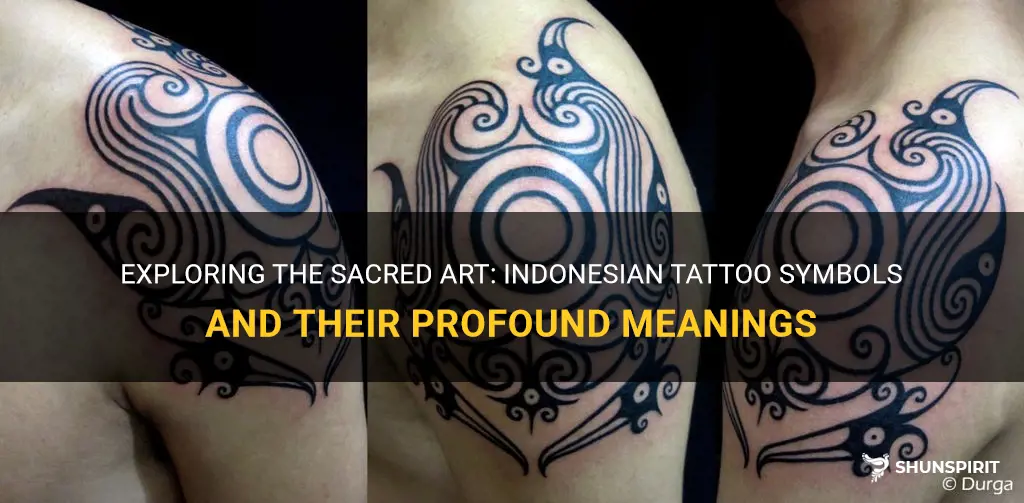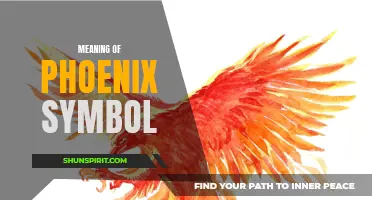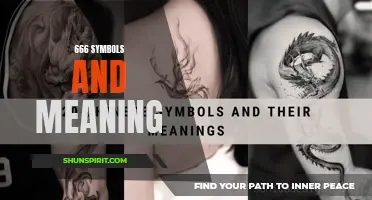
Indonesian culture is rich with intricate and meaningful traditions, and one of the most fascinating aspects is their tattoo symbols and their deep-rooted meanings. These remarkable designs represent a deeply ingrained belief system, cultural heritage, and spiritual significance that has been passed down through generations. Each symbol tells a unique story, representing different aspects of life, from bravery and protection to love and fertility. Discovering the hidden meanings behind these Indonesian tattoo symbols is like unraveling a captivating tale, revealing the extraordinary depths of this ancient culture.
What You'll Learn
- What are the most common Indonesian tattoo symbols and what do they mean?
- Are there any specific Indonesian tattoo symbols that are considered sacred or have spiritual significance?
- How have Indonesian tattoo symbols and meanings evolved over time?
- Are there any cultural or historical factors that have influenced the symbolism behind Indonesian tattoos?
- Can you give examples of Indonesian tattoo symbols and their meanings in different regions of Indonesia?

What are the most common Indonesian tattoo symbols and what do they mean?
Indonesia is a country rich in cultural heritage and traditions, and this is often reflected in its various art forms, including tattooing. Indonesian tattoos are known for their intricate designs and deep symbolism. There are several common symbols used in Indonesian tattoos, each with its own meaning and significance.
One of the most common Indonesian tattoo symbols is the Garuda, a mythical bird-like creature with wings, beak, and claws. The Garuda symbolizes power, courage, and protection. It is considered the national emblem of Indonesia and is often associated with the Hindu god Vishnu, who rides on the Garuda.
Another popular symbol in Indonesian tattoos is the Lotus flower, which represents purity, enlightenment, and spiritual growth. The Lotus is often depicted in various stages of bloom, with each stage representing different aspects of life's journey. In Indonesian culture, the Lotus is associated with the idea of divine beauty and the search for spiritual enlightenment.
The Wayang Kulit, or shadow puppet, is also a common symbol in Indonesian tattoos. Wayang Kulit is a traditional form of puppetry that tells stories from the Hindu epics Ramayana and Mahabharata. The puppets are made of cowhide and cast shadows on a screen, creating a captivating visual spectacle. In tattoo form, the Wayang Kulit symbolizes storytelling, wisdom, and the preservation of ancient traditions.
One more commonly seen Indonesian tattoo symbol is the Keris, a traditional Indonesian dagger with a wavy blade and a unique handle. The Keris is a symbol of honor, bravery, and protection. It is believed to possess magical powers and is often considered a spiritual weapon. The Keris has deep cultural significance in Indonesia and is often passed down through generations.
In addition to these symbols, Indonesian tattoos often feature various tribal designs and patterns. These designs can vary greatly depending on the specific tribe and region they come from. Tribal tattoos in Indonesia are often seen as a symbol of identity and belonging. They can represent a person's ancestry, social status, or even serve as a form of spiritual protection.
It is important to note that although these symbols have cultural significance, it is essential to approach them with respect and understanding. Indonesian tattoos are deeply intertwined with the country's history, spirituality, and culture. They should not be taken lightly or used for mere fashion or trend. It is always best to consult with a knowledgeable tattoo artist who can guide you in selecting the right symbol and design to ensure the proper interpretation and representation of Indonesian heritage.
In conclusion, Indonesian tattoos are rich in symbolism and reflect the cultural heritage and traditions of the country. Some of the most common symbols include the Garuda, Lotus flower, Wayang Kulit, and Keris. These symbols hold deep meanings related to power, spirituality, storytelling, and protection. When considering an Indonesian tattoo, it is essential to approach the symbols with respect and seek guidance from a knowledgeable artist to ensure the proper representation and appreciation of Indonesian culture.
Rock Symbolism: Exploring the Meaning of Rocks in Different Cultures
You may want to see also

Are there any specific Indonesian tattoo symbols that are considered sacred or have spiritual significance?
Tattoos have been used as a form of body art and self-expression for centuries. In Indonesia, there are several tattoo symbols that are considered sacred or have spiritual significance. These symbols are deeply rooted in Indonesian culture and hold great importance to the people who wear them.
One of the most well-known Indonesian tattoo symbols is the Garuda. The Garuda is a mythical bird-like creature that appears in both Hindu and Buddhist mythology. It is often depicted as a powerful bird with wings and a human-like body. The Garuda is associated with power, strength, and protection, and is considered the mount of Vishnu, a major Hindu deity. Many people choose to get a tattoo of the Garuda to symbolize these qualities and invoke their protective powers.
Another popular Indonesian tattoo symbol is the Barong. The Barong is a mythical creature that is often depicted as a lion-like creature. It is considered the king of spirits and is believed to protect against evil spirits and bring good luck. The Barong is also associated with Balinese Hinduism and is often seen in traditional dance performances and rituals. Getting a Barong tattoo can be seen as a way to invite the protective and luck-bringing powers of this mythical creature into one's life.
The Aksobhya Buddha is another symbol commonly seen in Indonesian tattoos. Aksobhya is one of the five Dhyani Buddhas in Mahayana Buddhism and represents the transformation of anger and hatred into wisdom and compassion. Many people get a tattoo of the Aksobhya Buddha as a reminder to cultivate these positive qualities in their own lives and to seek enlightenment.
In addition to these specific symbols, many Indonesian tattoos incorporate traditional patterns and designs that hold spiritual significance. These patterns often symbolize aspects of nature such as waves, mountains, and animals, and can represent various spiritual concepts such as balance, harmony, and the interconnectedness of all things. These patterns are often passed down through generations and hold a deep spiritual meaning to those who wear them.
It's important to note that getting a tattoo of a sacred or spiritual symbol in Indonesia is a serious decision, and it is important to approach it with respect and understanding. These symbols hold great significance to the culture and the people who practice them, and it is important to research and understand the meaning and cultural context behind the symbol before getting it tattooed on one's body.
In conclusion, there are several Indonesian tattoo symbols that are considered sacred or have spiritual significance. These symbols, such as the Garuda, Barong, and Aksobhya Buddha, hold deep cultural and spiritual importance to the Indonesian people. Additionally, traditional patterns and designs incorporating elements of nature and spirituality are also common in Indonesian tattoos. It is important to approach these symbols with respect and understanding, as they have great significance to the culture and should be treated as such.
Understanding the Nissan Titan Dashboard Symbols and Their Meanings
You may want to see also

How have Indonesian tattoo symbols and meanings evolved over time?
Indonesia has a rich and diverse tattoo culture that dates back thousands of years. Throughout history, tattoos in Indonesia have held various meanings and symbolism, reflecting the beliefs, traditions, and social status of different communities. Over time, these symbols and meanings have evolved and adapted to changing cultural and societal norms.
Traditional Indonesian tattoos, known as tato or tatu, were closely associated with folklore, spiritual beliefs, and traditional practices. They were used as a form of protection, to symbolize courage and bravery, and to mark important milestones and events in a person's life. Tattoo artists, known as tukang tatu, were highly respected members of the community and possessed specialized knowledge and skills to create intricate designs.
One of the most well-known tattoo traditions in Indonesia is the Dayak tattoos of Borneo. Dayak tattoos were worn by both men and women and were believed to have protective and spiritual properties. The Dayak people regarded tattoos as a form of armor against evil spirits and a way to connect with their ancestors. Different designs and motifs were used to represent bravery, fertility, status, and personal achievements.
In addition to the Dayak tattoos, Javanese traditional tattoos also hold significant cultural and symbolic meanings. Javanese tattoos, known as tatu Jawa, were mainly worn by the royal family and noble classes. These tattoos were seen as a way to show social status and were often intricate and geometric in design. Each symbol and motif had a specific meaning, such as protection, power, and prosperity.
However, with the influence of Western culture and the spread of Islam in Indonesia, tattooing became less common and even frowned upon in some communities. The rise of Islam led to a decline in traditional tattoo practices, as the religion discourages the alteration of the body. Consequently, many traditional Indonesian tattoo symbols and meanings became less prominent and widely understood.
In recent years, there has been a revival of interest in traditional Indonesian tattoos, fueled by a resurgence of cultural pride and a desire to reconnect with ancestral heritage. Younger generations are now seeking to reclaim their cultural identity through the art of tattooing and are rediscovering the symbols and meanings of their ancestors. Tattoo artists and enthusiasts are exploring traditional designs and incorporating them into modern interpretations, creating a fusion of old and new.
Today, Indonesian tattoo symbols and meanings continue to evolve, reflecting the changing society and individual interpretations. While traditional designs and motifs still carry cultural significance, new symbols and meanings have emerged, influenced by contemporary themes and personal experiences. Tattoos have become a form of self-expression and a way to preserve and celebrate Indonesian heritage.
In conclusion, Indonesian tattoo symbols and meanings have evolved over time due to various factors such as cultural changes, religious influences, and individual interpretations. From being deeply rooted in folklore and spirituality to being less prevalent in certain communities, traditional Indonesian tattoos have experienced a resurgence in recent years. As the country continues to embrace its rich cultural heritage, tattooing remains a powerful form of self-expression and a way to preserve and celebrate Indonesian traditions.
Decoding the Symbols: Understanding the Meaning Behind Dyson Air Purifier Symbols
You may want to see also

Are there any cultural or historical factors that have influenced the symbolism behind Indonesian tattoos?
Indonesian tattoos, with their rich and vibrant culture, have a deep-rooted symbolism that is influenced by cultural and historical factors. These tattoos hold significant meaning, and each design tells a story about the person wearing it. From the ancient tribes to modern times, the symbolism behind Indonesian tattoos has evolved and adapted to reflect the changing society.
One of the cultural factors that have influenced Indonesian tattoos is the diverse ethnic groups residing in the archipelago. Indonesia consists of over 17,000 islands and is home to more than 300 ethnic groups, each with its own distinct cultural practices and beliefs. This diversity is reflected in the different tattoo designs, patterns, and symbols found across the country.
The historical factors that have shaped Indonesian tattoo symbolism can be traced back to ancient times. The indigenous tribes in Indonesia, such as the Dayak, Batak, and Mentawai, have a long tradition of tattooing. These tribes used tattoos as a form of cultural identity, indicating social status, protection, and spiritual beliefs. The tattoos were often inked using traditional methods, such as hand-tapping, using natural pigments sourced from plants and insects.
The symbols and motifs used in Indonesian tattoos are deeply rooted in the spiritual and cultural practices of these tribes. For example, the Dayak people believe that tattoos protect the wearer from evil spirits and can enhance their strength and bravery. They use various animal symbols, such as crocodiles, snakes, and dragons, to represent power and protection.
In addition to the indigenous tribes, Indonesian tattoos have also been influenced by various external cultures and historical events. The arrival of Islam in Indonesia during the 13th century brought about new tattoo practices and symbolism. Islam discourages the drawing of tattoos, as it is considered haram (forbidden) in the religion. However, Indonesian Muslims have incorporated Islamic calligraphy and symbols into their tattoos, blending traditional cultural practices with religious beliefs.
The Dutch colonization of Indonesia in the 17th century also left an impact on Indonesian tattoo symbolism. During this time, tattoos became a mark of resistance and rebellion against the Dutch oppressors. The symbols used in these tattoos often represented freedom, nationalism, and defiance.
As Indonesia modernized and became a nation-state, the symbolism behind Indonesian tattoos shifted to reflect contemporary society. Today, Indonesian tattoos often incorporate elements of pop culture, such as music, sports, or popular icons. Younger generations are creating fusion designs that combine traditional Indonesian motifs with modern influences, showcasing the dynamic nature of Indonesian tattoo symbolism.
In conclusion, the symbolism behind Indonesian tattoos is deeply influenced by cultural and historical factors. The diverse ethnic groups and their cultural practices, as well as significant historical events, have shaped the meanings and symbolism behind Indonesian tattoos. From ancient tribal traditions to contemporary fusion designs, Indonesian tattoos continue to evolve, representing the rich cultural heritage of this vast archipelago.
Exploring the Meaning Behind the Battery with Recycle Symbol
You may want to see also

Can you give examples of Indonesian tattoo symbols and their meanings in different regions of Indonesia?
Indonesia is a country rich in culture and traditions. One aspect of this cultural diversity can be seen in the art of tattooing. Tattoos have been a part of Indonesian culture for centuries, and each region has its own unique symbols and meanings associated with them. In this article, we will explore some Indonesian tattoo symbols and their meanings in different regions of Indonesia.
Dayak Tribe of Borneo:
The Dayak tribe of Borneo is known for their intricate tattoos. The tattoos are often inspired by nature and animals. One popular symbol is the hornbill, which symbolizes bravery and strength. Another common symbol is the crocodile, representing protection and fertility. The tattoos are often done using black ink, and the designs are created using intricate dotwork.
Mentawai Tribe of Sumatra:
The Mentawai tribe of Sumatra is known for their traditional hand-tapped tattoos. These tattoos are applied using a small stick with a needle attached to it, which is then tapped into the skin. The designs often depict various nature elements such as waves, trees, and animals. One common symbol is the tiger, which signifies protection and strength. The tattoos are done in black ink, and the designs are highly detailed and symmetrical.
Toraja Tribe of Sulawesi:
The Toraja tribe of Sulawesi is famous for their traditional tattoos, which are believed to protect the wearer from evil spirits. One common symbol is the buffalo, which represents prosperity and fertility. The tattoos are typically done in black ink and are often placed on the chest or the upper arm. The designs are bold and typically feature geometric patterns and abstract shapes.
Asmat Tribe of Papua:
The Asmat tribe of Papua is known for their intricate body art, which includes both tattoos and scarification. The tattoos are often done using dark pigments made from natural materials such as charcoal. The designs often depict various animals and mythological creatures. One common symbol is the crocodile, which symbolizes protection and power. The tattoos are typically applied using a thorn or a piece of sharpened bone.
Bali:
Bali is known for its rich artistic traditions, including tattooing. Balinese tattoos often feature traditional Hindu symbols and deities. One common symbol is the Barong, a mythical creature that represents good fortune and protection. Another popular symbol is the Om symbol, which represents harmony and spiritual enlightenment. The tattoos are typically done in black ink and often incorporate intricate details and patterns.
In conclusion, Indonesian tattoo symbols vary in meaning and significance depending on the region. From the detailed dotwork of the Borneo tribes to the symmetrical designs of the Mentawai tribe, each region has its own unique tattooing traditions. Whether you are interested in the protective symbols of the Toraja tribe or the Hindu-inspired tattoos of Bali, Indonesian tattoo art offers a fascinating glimpse into the rich cultural diversity of the country.
Decoding the Symbols: Understanding the Meaning Behind Night Owl Security Camera Symbols
You may want to see also
Frequently asked questions
Some common Indonesian tattoo symbols include the Garuda, which represents power and protection, the Wayang Kulit, which signifies storytelling and cultural heritage, and the Batik patterns, which symbolize beauty and tradition.
Indonesian tattoo symbols have deeper meanings beyond just aesthetics. They often represent cultural heritage, spiritual beliefs, and personal values. Each symbol carries its own significance and story, making Indonesian tattoos meaningful and meaningful.
Yes, you can definitely get an Indonesian tattoo even if you are not from Indonesia. Tattoos are a form of self-expression, and people from all around the world incorporate different cultural symbols into their body art. However, it is important to understand and respect the cultural significance of the symbols you choose to tattoo.







